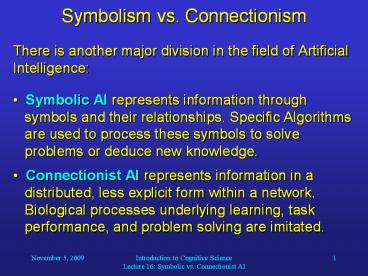Symbolism vs. Connectionism PowerPoint PPT Presentation
Title: Symbolism vs. Connectionism
1
Symbolism vs. Connectionism
- There is another major division in the field of
Artificial Intelligence - Symbolic AI represents information through
symbols and their relationships. Specific
Algorithms are used to process these symbols
to solve problems or deduce new knowledge. - Connectionist AI represents information in a
distributed, less explicit form within a
network. Biological processes underlying
learning, task performance, and problem
solving are imitated.
2
Symbolic AI
- One of the paradigms in symbolic AI is
propositional calculus. - In propositional calculus, features of the world
are represented by propositions. - Relationships between features (constraints) are
represented by connectives. - Example
- LECTURE_BORING ? TIME_LATE ? SLEEP
- This expression in propositional calculus
represents the fact that for some agent in our
world, if the features LECTURE_BORING and
TIME_LATE are both true, the feature SLEEP is
also true.
3
The Language
- Atoms
- The atoms T and F and all strings that begin with
a capital letter, for instance, P, Q,
LECTURE_BORING, and so on. - Connectives
- ? or
- ? and
- ? implies or if-then
- ? not
4
Rules of Inference
- We use rules of inference to generate new
expressions from existing ones. - One important rule is called modus ponens or the
law of detachment. It is based on the tautology
(P ? (P ? Q)) ? Q. We write it in the following
way - P
- P ? Q
- _____
- ? Q
The two hypotheses P and P ? Q are written in a
column, and the conclusionbelow a bar, where ?
means therefore.
5
Rules of Inference
?Q P ? Q _____ ? ?P
- P
- ______
- ? P?Q
Modus tollens
Addition
P ? Q Q ? R _______ ? P ? R
P?Q _____ ? P
Hypothetical syllogism
Simplification
P Q ______ ? P?Q
P?Q ?P _____ ? Q
Conjunction
Disjunctive syllogism
6
Rules of Inference
- Example
- Gary is intelligent, or he is a good actor.
- If Gary is intelligent, then he can count from 1
to 10. - Gary can only count from 1 to 2.
- Therefore, Gary is a good actor.
- Propositions
- I Gary is intelligent.
- A Gary is a good actor.
- C Gary can count from 1 to 10.
7
Rules of Inference
- I Gary is intelligent.A Gary is a good
actor.C Gary can count from 1 to 10. - Step 1 ?C Hypothesis
- Step 2 I ? C Hypothesis
- Step 3 ?I Modus Tollens Steps 1 2
- Step 4 A ? I Hypothesis
- Step 5 A Disjunctive Syllogism Steps 3
4 - Conclusion A (Gary is a good actor.)
8
Computers vs. Neural Networks
- Standard Computers Neural Networks
- one CPU highly parallel processing
- fast processing units slow processing units
- reliable units unreliable units
- static infrastructure dynamic infrastructure
9
Why Artificial Neural Networks?
- There are two basic reasons why we are interested
in building artificial neural networks (ANNs) - Technical viewpoint Some problems such as
character recognition or the prediction of future
states of a system require massively parallel
and adaptive processing. - Biological viewpoint ANNs can be used to
replicate and simulate components of the human
(or animal) brain, thereby giving us insight
into natural information processing.
10
Why Artificial Neural Networks?
- Why do we need another paradigm than symbolic AI
for building intelligent machines? - Symbolic AI is well-suited for representing
explicit knowledge that can be appropriately
formalized. - However, learning in biological systems is
mostly implicit it is an adaptation process
based on uncertain information and
reasoning. - ANNs are inherently parallel and work extremely
efficiently if implemented in parallel
hardware.
11
How do NNs and ANNs work?
- The building blocks of neural networks are the
neurons. - In technical systems, we also refer to them as
units or nodes. - Basically, each neuron
- receives input from many other neurons,
- changes its internal state (activation) based on
the current input, - sends one output signal to many other neurons,
possibly including its input neurons (recurrent
network)
12
How do NNs and ANNs work?
- Information is transmitted as a series of
electric impulses, so-called spikes. - The frequency and phase of these spikes encodes
the information. - In biological systems, one neuron can be
connected to as many as 10,000 other neurons. - Usually, a neuron receives its information from
other neurons in a confined area, its so-called
receptive field.
13
How do NNs and ANNs work?
- In biological systems, neurons of similar
functionality are usually organized in separate
areas (or layers). - Often, there is a hierarchy of interconnected
layers with the lowest layer receiving sensory
input and neurons in higher layers computing more
complex functions. - For example, neurons in macaque visual cortex
have been identified that are activated only when
there is a face (monkey, human, or drawing) in
the macaques visual field.
14
How do NNs and ANNs work?
- NNs are able to learn by adapting their
connectivity patterns so that the organism
improves its behavior in terms of reaching
certain (evolutionary) goals. - The strength of a connection, or whether it is
excitatory or inhibitory, depends on the state of
a receiving neurons synapses. - The NN achieves learning by appropriately
adapting the states of its synapses.
15
An Artificial Neuron
synapses
- o1
neuron i
o2
wi1
wi2
oi
win
on
net input signal
activation
output

